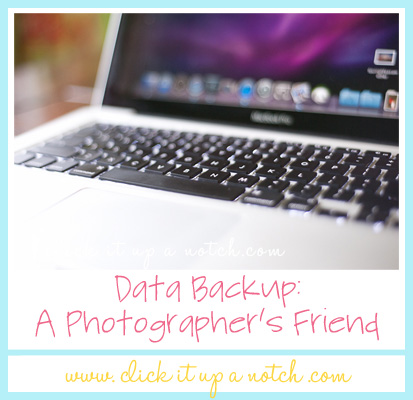Technology has come a long way in a very short period in the computer industry. The rise of mobile devices, cloud services, and the mantra of “access to data from anywhere” has pushed our dependence on that data to new levels. But behind those new, useful tools, are still some of the same problems that often fall by the wayside. One of those is data backup. As photographers, this is extremely important since your images are often stored digitally.
Why backup?
All of us have ever-growing treasure troves of data: pictures, movies, music, financial records, documents, and a host of other files that we will always need access to. Even though the number of ways we can access that data and the number of services that can help us access that data are increasing, behind them all remains computer hardware that is not infallible. We still have to protect ourselves from that rainy day where data loss will occur, and although it’s cliché, remember that it’s not a matter of if you lose data, but when.
Data loss (or potential data loss) occurs far more often than people think. Just looking at hard disk failures shows us that about 1 out of every 15 hard drives fail over any five year period. But hard drive failure isn’t the only threat to data. Viruses or malware can easily render data inaccessible. And who hasn’t been the victim of an accidental deletion of files, or deleting what was thought to be non-pertinent data only to find that you then need something from it? For all of these reasons, any computer user needs to make data backup a priority. It must be thought of as insurance – a little protection that is required to prevent the catastrophic disaster.
Beyond the disaster recovery aspect, backups can have other benefits. In the case of a small business, especially one where you routinely work on customer’s data, having archived backups can be a product selling point. Clients may come back to you at a future date requesting copies of their data. Having that data backed up and available for the client to purchase can bring in some extra money. What if one of your clients wants to buy a canvas of an image you took a year ago. You don’t want to tell them that your hard drive crashed and you no longer have those images. You will be losing out on a profit as well as possibly losing a loyal client.
Types of data backup
These days, we have several options for data backup, many of which that are relatively easy to implement and low-cost. One of the first decisions is where to back up your data:
On-site backup:
Back up your files to another location but still at or near your computer. This is a classic backup scenario, and is appropriate for large amounts of data, as well as data that you may not trust to a 3rd-party.
Appropriate media to back up might be:
–External hard drive: Most commonly connected with USB although IEEE-1394 (Firewire) and eSATA are also available, if your computer has these connections. A great option for large amounts of data, and portable so that the data can be accessed from another computer.
–Additional internal hard drive: Can be faster than an external hard drive due to use of the computers native internal SATA connections. However, it is not portable, and in most cases, the drive is online while the computer is running, leaving the backed up data vulnerable to viruses/malware.
–Dock/caddy hard drive system: These systems allow multiple hard drives to be placed in caddies, which can then be inserted into the computer in a dock one at a time. This allows multiple hard drives to be switched in and out at will. This has many advantages, including native speeds, unlimited storage (just purchase drives and caddies) and portability.
–USB Flash drive: More reliable than hard drives, but slower and only appropriate for smaller amounts of data. Fully portable, however.
–Optical media: Using CD-R, DVD-R, or BD-R offers unlimited space, and the media is inexpensive. Slow to backup, however, and can be problematic if the size of the backup exceeds the size of a single piece of media. In that case, the user must be able to insert new media during the backup, which makes the backup non-automated.
–Server or NAS: Offers a centralized location to backup multiple computers, and frequently increases the ability to access the data as well. However, cost can be an issue, and is not portable.
Off-site backup:
Back up your files to some type of portable media and then carry the portable media off-site to another location. Appropriate for critical data that would need to survive disasters such as fire or flood at the primary location.
Any of the aforementioned portable backup media will work, including external hard drive, dock/carry hard drives, USB flash drive, or optical media.
Cloud Services backup:
One of the newest and easiest-to-use solutions, the software from these services backs up your data over the Internet to the company’s private servers. Two of the most popular services are Carbonite and Mozy.
Advantages
-Easy-to-use software included with both – set what to backup and you’re done.
-Automated backups, no user intervention required.
-Inexpensive
Disadvantages
-Requires high-speed internet connection in the upload direction. Many DSL and Cable services have upload speeds that are far less than the download speeds, so this can be an issue that will cause slow or very slow backups.
-Not appropriate for large amounts of data since the initial backup will take a very long time.
-Some internet services meter or otherwise “cap” your internet connection. Cloud backup services can cause overages if this is the case with your internet provider.
-May not be appropriate for extremely private files such as financial data, since the data is in the hands of a 3rd-party.
Which backup software should I use?
The capabilities and backup performance that you will eventually get depend a lot on the backup software you will use. For the cloud services, both Mozy and Carbonite come with their own software that operates with their service. If you have a server or NAS solution, some of those units come with their own backup software that can be deployed. If you just have an external hard drive, then you’re left with either manually copying your files periodically (no fun), or using backup software to automate the process.
Furthermore, you’ll need to decide whether you want to do a data-only backup, or whether you want the luxury of backing up the entire computer (known as an image backup).
Data-only backup:
Backs up your data files, but not the operating system and program files. This meets the needs of a basic backup system. If you need to restore this backup because your computer or hard drive malfunctioned, you will have to prepare or otherwise obtain a new computer or hard drive, and reload your operating system as well as your programs first.
-Mozy and Carbonite are typically data-only backup services.
-You can effectively do a data-only backup without any backup software simply by copying your data files to your backup media. However, this process is not automated.
-Dedicated backup software like Norton Ghost or Acronis True Image can also do data-only backups.
Whole-computer (Image) backup:
Backs up the entire computer, including operating system, programs, and data. This type of backup can be restored to a brand-new blank hard drive, and the computer will be exactly as it was.
-Norton Ghost, Acronis True Image, and several other software packages can do this type of backup. Some of these packages can even restore the image to dissimilar hardware, which is useful if you need to buy a completely new computer and the model you had isn’t made anymore.
-This type of backup can be fully automated and scheduled.
Don’t ever be caught without a backup of your important files. No feeling in the world is more deflating than the one that sinks in when you realize your data is gone.
Avoid putting yourself in that position by always having a backup – turn the catastrophic disaster into only a minor inconvenience.
What type of data back up do you use? Did you find some useful tips?
Full Dimension IT Solutions

Website | Facebook








This is great information. I like how it is all in one place for every option. Thank you.
Thanks for sharing this informative information. Love it. It will really help me a lot.
Very useful. I have been trying to decide what I should do. It seems external hard drive might be the best for me.
How do you select one? That’s the next question.
It depends if you use a Mac or a PC. I use a Mac and there is a link to a post where I talk about which EHD I use – http://clickitupanotch.com/2011/07/5-ways-to-back-up-photos/
It’s perfect time to make some plans for the longer term and it’s
time to be happy. I have read this put up and if I could I desire to recommend you few attention-grabbing issues or tips.
Maybe you can write next articles referring to this article.
I desire to learn even more things approximately it!
you’re in point of fact a just right webmaster. The website loading pace
is amazing. It seems that you’re doing any unique trick.
Furthermore, The contents are masterwork. you have performed a great job in this subject!